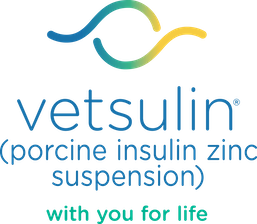

Urine Testing
Read More About Monitoring & Controlling Feline Diabetes
Evaluation and Monitoring by Urine Tests
If used in conjunction with spot glucose measurements and evaluation of clinical signs, urine sampling can be a valuable monitoring tool. Urine only tests positive for glucose if the blood glucose concentration remains above the renal threshold for a substantial period of time. This occurs when glycemia reaches 200-280 mg/dL (11.1-15.6 mmol/L) in the cat.
Urine monitoring is also a quick and easy method of detecting ketonuria and hence a potential emergency. See diabetic ketoacidosis for more information. However, when you need to adjust a pet’s insulin dose, evaluate glycemia by performing a glucose curve. Unlike a blood glucose curve, urine sampling cannot confirm hypoglycemia. Urine sugar can be negative when the cat’s blood glucose is normal or low.
Clients Can Use Two Protocols to Test Urine:
1. Have the pet owner test urine 3 times a day: before the first meal (test 1), before the second meal (test 2), and late in the evening (test 3). (No change in feeding schedule is required for cats fed ad libitum.)
Refer to the following table:
| TEST 1 | TEST 2 | TEST 3 | Action Recommended |
|---|---|---|---|
| Trace | – | – | None |
| + | – | – | None |
| Trace | – | Trace | Duration of Vetsulin activity may be a little too short. Perform glucose curve. |
| + | – | + | Potential Somogyi effect. Perform glucose curve. |
| + | + | + | Dose potentially too low. Perform glucose curve. |
| – | – | – | Dose potentially too low. Perform glucose curve. |
2. Ask the pet owner to closely monitor a 24-hour period by collecting as many urine samples as possible. A persistent glycosuria will indicate the need for a complete re-evaluation and glucose curve.
There are special litter crystals available that can be added to the litter and change color to indicate the cat’s urine glucose levels. Urine collection can also be facilitated by using special cat litter, such as hydrophobic sand.
Resources to Help Clients Monitor Care
Help Your Practice Manage Diabetes Mellitus
Check out these tools and resources to help manage feline diabetes.

Blood Glucose Curve Generator
Create a blood glucose curve to monitor and evaluate diabetes treatments.

Client Discharge Form
Create a customized, printable form for clients about their new diagnosis.

Diabetes Resources
Access online tools and more to support staff and pet parents.
No items to show.
Read More About Monitoring & Controlling Feline Diabetes
Important Safety Information:
Vetsulin® should not be used in dogs known to have a systemic allergy to pork or pork products. Vetsulin is contraindicated during periods of hypoglycemia. Keep out of reach of children. As with all insulin products, careful patient monitoring for hypoglycemia and hyperglycemia is essential to attain and maintain adequate glycemic control and prevent associated complications. Overdosage can result in profound hypoglycemia and death. The safety and effectiveness of Vetsulin in puppies, breeding, pregnant, and lactating dogs has not been evaluated. See package insert for full information regarding contraindications, warnings, and precautions.
References:
1. Martin GJ, Rand JS. Pharmacology of a 40 IU/ml porcine lente insulin preparation in diabetic cats: findings during the first week and after 5 or 9 weeks of therapy. J Feline Med Surg. 2001;3(1):23–30. 2. Vetsulin® (porcine insulin zinc suspension) [Freedom of Information Summary]. Millsboro, DE: Intervet Inc.; 2008. 3. Data on file, Merck Animal Health. 4. Graham PA, Nash AS, McKellar QA. Pharmacokinetics of porcine insulin zinc suspension in diabetic dogs. J Small Anim Pract. 1997;38(10):434–438. 5. Martin GJ, Rand JS. Pharmacokinetic and Pharmacodynamic Study of Caninsulin in Cats with Diabetes Mellitus. 2000: Internal Study Report. 6. Feldman EC, Nelson RW. Canine and Feline Endocrinology and Reproduction. 3rd ed. St. Louis, MO: Saunders; 2004:539–579. 7. Tennant B, ed. BSAVA Small Animal Formulary. 4th ed. Gloucestershire, UK: British Small Animal Veterinary Association; 2002. 8. Feldman EC, Nelson RW. Canine and Feline Endocrinology and Reproduction. 3rd ed. St. Louis, MO: Saunders; 2004:486–538. 9. Reusch C. Feline diabetes mellitus. In: Ettinger SJ, Feldman EC, eds. Textbook of Veterinary Internal Medicine. 7th ed. St. Louis, MO: Saunders; 2010:1796–1816. 10. Nelson RW. Canine diabetes mellitus. In: Ettinger SJ, Feldman EC, eds. Textbook of Veterinary Internal Medicine. 7th ed. St. Louis, MO: Saunders; 2010:1782–1796. 11. Burgaud S, Riant S, Piau N. Comparative laboratory evaluation of dose delivery using a veterinary insulin pen. In: Proceedings of the WSAVA/FECAVA/BSAVA congress; 12–15 April 2012; Birmingham, UK. Abstract 121. 12. Burgaud S, Guillot R, Harnois-Milon G. Clinical evaluation of a veterinary insulin pen in diabetic dogs. In: Proceedings of the WSAVA/ FECAVA/BSAVA congress; 12–15 April 2012; Birmingham, UK. Abstract 122. 13. Burgaud S, Guillot R, Harnois-Milon G. Clinical evaluation of a veterinary insulin pen in diabetic cats. In: Proceedings of the WSAVA/FECAVA/BSAVA congress; 12–15 April 2012; Birmingham, UK. Abstract 45. 14. Davison LJ, Walding B, Herrtage ME, Catchpole B. Anti-insulin antibodies in diabetic dogs before and after treatment with different insulin preparations. J Vet Intern Med. 2008;22:1317-1325. 15. Banfield State of Pet Health 2016 Report. p 12-13.
